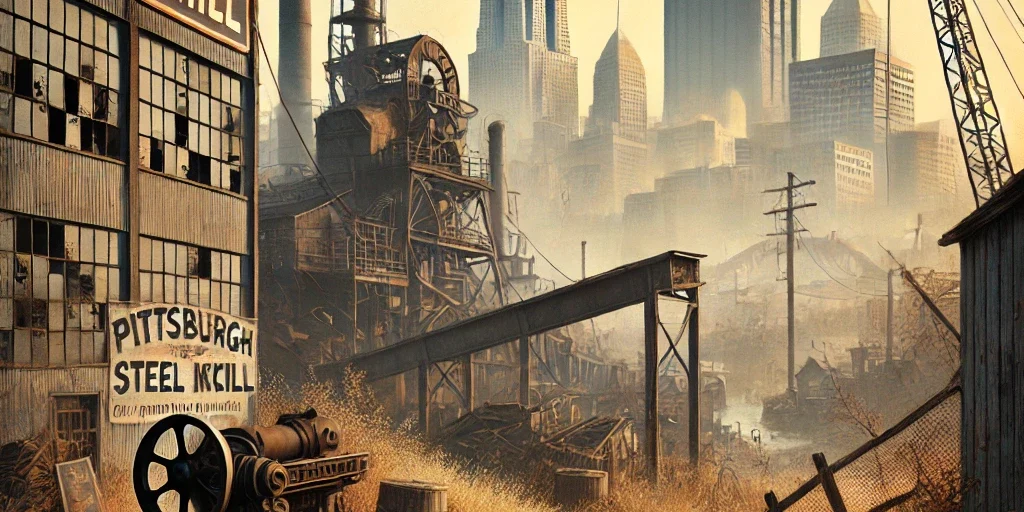Why did Pittsburgh’s steel industry collapse? To understand the answer, we need to go back to a time when the city wasn’t known for tech startups or top-tier hospitals. In the late 19th and early 20th centuries, Pittsburgh earned the nickname “Steel City” — and for good reason. This is the story of how it became the epicenter of American steel production, the triumphs and struggles that marked its peak, and the dramatic decline that forced the city to reinvent itself. It’s a tale of industrial tycoons and immigrant workers, technological innovation and brutal labor clashes, wartime booms and economic busts. Through vivid anecdotes and historical milestones, let’s journey through the rise and fall of Pittsburgh’s steel industry — an era that forged a city’s identity in fire and iron.
Foundations of a Steel City
Before the skyscrapers and tech startups, Pittsburgh’s natural geography made it a prime location for heavy industry. The city sits at the junction of the Allegheny and Monongahela Rivers, which merge to form the Ohio River – a strategic advantage for transporting raw materials and finished steel. But the real fuel of Pittsburgh’s industrial future lay beneath its hills: rich deposits of coal and iron ore.
By the early 1800s, small iron foundries and mills dotted the region, producing tools, nails, and rail tracks. However, it was Andrew Carnegie, a poor Scottish immigrant turned industrial titan, who ignited the true steel boom. After working his way up in the railroad industry, Carnegie traveled to Britain in the 1860s and witnessed a revolutionary process for mass-producing steel: the Bessemer process. Recognizing its potential, he returned to Pittsburgh, opened the J. Edgar Thomson Steel Works in 1875, and introduced America to rapid, large-scale steel production. The city’s destiny was forever changed.
The Rise of Carnegie’s Steel Empire

With unmatched ambition, Carnegie expanded aggressively, acquiring rival mills and controlling every step of production — from mining iron ore to transporting finished steel on his own railroads. By the late 1880s, Pittsburgh was producing more steel than any other city in the world. In fact, Carnegie Steel alone accounted for a staggering 25% of global steel output.
Yet, this boom came at a cost. Workers in Pittsburgh’s mills faced grueling 12-hour shifts in blistering heat for meager wages. Labor unrest simmered for years before finally boiling over in the infamous Homestead Strike of 1892. Carnegie’s business partner, Henry Clay Frick, attempted to crush the union at the Homestead Steel Works, hiring armed Pinkerton agents to break the strike. Violence erupted along the Monongahela River, leaving ten dead and many more injured. The strike was ultimately defeated, dealing a devastating blow to organized labor.
Despite the unrest, Carnegie’s empire continued growing. In 1901, at the peak of his success, he sold his company to J.P. Morgan for an astounding $480 million (equivalent to over $15 billion today). Morgan merged it with other firms to form United States Steel Corporation (U.S. Steel), the world’s first billion-dollar corporation. Pittsburgh had officially become the Steel Capital of the World.
The Peak of the Steel City
By the early 20th century, Pittsburgh’s skyline was dominated by towering smokestacks and sprawling mill complexes. Companies like Jones & Laughlin, U.S. Steel, and Allegheny Ludlum churned out steel for the nation’s bridges, skyscrapers, and railroads. By the 1940s, Pittsburgh was producing nearly half of the nation’s steel output.
World War II saw the industry reach its zenith. Pittsburgh’s mills ran 24/7 to supply steel for battleships, tanks, and aircraft. At the height of the war, 20% of the world’s steel came from Pennsylvania, much of it from Pittsburgh.
Yet, with prosperity came environmental consequences. The city became infamous for its thick, black smog. By the 1940s, streetlights often stayed on at midday because industrial smoke blotted out the sun. Pittsburghers took pride in the pollution, joking that “the mills were not smoking when they were not working.” However, respiratory diseases soared, and by the 1950s, efforts to clean the city’s air were underway.
The Decline and Fall
Despite its dominance, cracks in Pittsburgh’s steel empire were forming. By the 1960s and 70s, foreign competition, outdated technology, and economic shifts undercut Pittsburgh’s advantage. Steelmakers in Japan and Europe adopted modern techniques like basic oxygen furnaces and continuous casting, making production cheaper and more efficient. Meanwhile, U.S. steel companies clung to aging open-hearth furnaces and ignored the warning signs.
When a major recession hit in 1981-82, Pittsburgh’s already struggling mills collapsed. Nearly 150,000 steelworkers lost their jobs, and unemployment in the region soared to 17% in 1983. Entire towns that depended on a single mill saw their lifeblood disappear. Young workers fled the region in search of jobs, leading to a population decline of 8% in just one decade.
The once-mighty Homestead Works, which had employed 15,000 workers, shut down for good in 1986. Today, its site houses a shopping center, with only a few relics left to remind visitors of its industrial past. Similar fates befell Jones & Laughlin Steel and other iconic Pittsburgh mills. As the mills went dark, shadows filled the void — including the rise of organized crime in Pittsburgh, which found opportunity in a city undergoing upheaval.
From Steel City to Tech Hub
The collapse of the steel industry could have doomed Pittsburgh to Rust Belt ruin, but instead, the city reinvented itself. Civic leaders and universities spearheaded a transition to healthcare, education, and technology. By the early 21st century, Pittsburgh gained recognition as a hub for robotics, artificial intelligence, and medical research.
Yet, the steel legacy endures. The city’s work ethic, immigrant roots, and industrial grit remain core to its identity. Landmarks like the Carrie Blast Furnaces and Homestead Pump House now stand as preserved monuments, where visitors can still feel the echoes of Pittsburgh’s steel past.
The story of Pittsburgh’s steel industry is one of innovation, conflict, and resilience. It built the modern world, but when the industry collapsed, the city refused to be buried in its ruins. The Steel City may no longer run on molten iron, but its foundation remains as strong as steel.
Frequently Asked Questions (FAQ)
Why did Pittsburgh’s steel industry collapse? Pittsburgh’s steel industry collapsed due to increased global competition, outdated production technology, economic recessions, and a failure to modernize.
How many steel mills were in Pittsburgh? At its peak, Pittsburgh was home to dozens of major steel mills. By the mid-20th century, companies like Carnegie Steel, Jones & Laughlin, and U.S. Steel dominated the industry.
Does Pittsburgh still produce steel today? Yes, Pittsburgh still produces steel, but on a much smaller scale. Modern facilities now focus primarily on specialty steel and niche markets.
Why is Pittsburgh called the Steel City? Pittsburgh earned the nickname “Steel City” because it became the world’s leading steel producer during the late 19th and early 20th centuries, symbolizing industrial strength and innovation.
How did the steel industry impact Pittsburgh’s environment? Pittsburgh’s heavy industry caused severe pollution, resulting in thick smog and significant respiratory health issues, prompting major cleanup efforts starting in the 1950s.
What happened to the steel workers after the collapse? After the collapse, many steelworkers faced unemployment and hardship. Many left the region for employment elsewhere, while others retrained for emerging industries like healthcare and technology.









